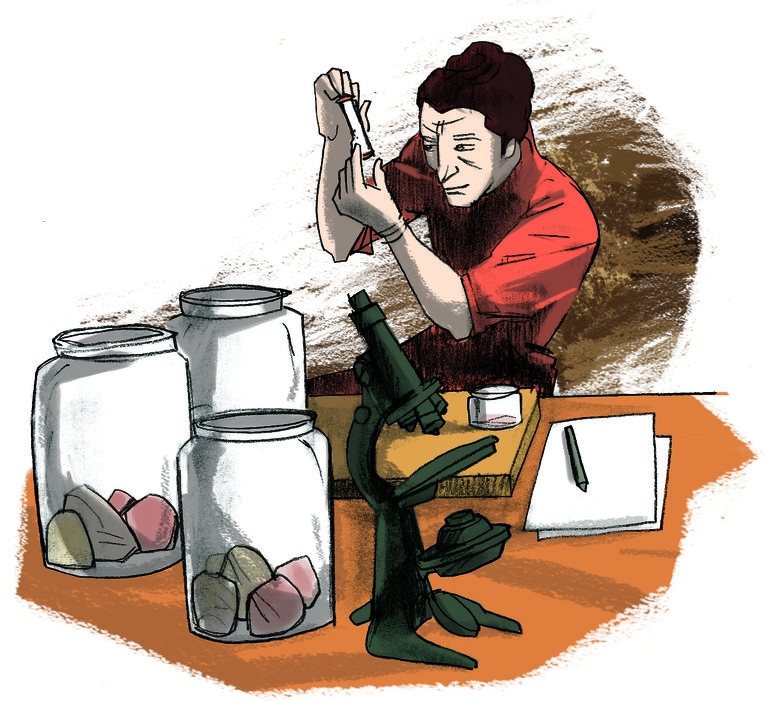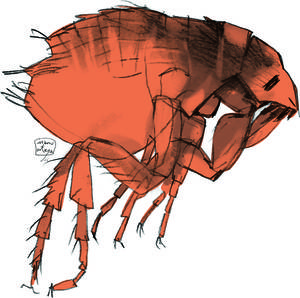Miriam Rothschild, birth zoologist

"There are not many people who feel love for fleas, but I love them," said Miriam Rothschill, showing half a dozen fleas in the palm of her hand. "They are fairies with an adequate dose of chloroform."
Miriam was born in 1908 in the prestigious family of Jewish bankers Rothschild. And it can be said that it almost belonged to the family since childhood. In fact, Father Charles had an immense collection of fleas; thousands of fleas collected worldwide (currently in the British Natural History Museum). He described about 500 species.
Miriam's father and uncle were some amateur zoologists. Uncle, Lionel Walter, 2. Baron Rothschild owned the largest animal collection collected by one person. More than 2 million butterflies and sits he had in his house museum, his brother's flea collection, 300,000 dried birds, 200,000 bird eggs, 30,000 beetles, hundreds of giant turtles, etc. He liked to walk through the cart pulled by the zebras, and at some point they saw him walking on a giant tortoise.
Miriam Rothschild grew up in that environment. I did not attend school because my father thought that formal education did not benefit intellectual creation at all. He was educated at home and in his uncle's museum.
He did his first research work with marine invertebrates. And at age 40 he dedicated himself to his father's fleas. He published his taxonomic and morphological study in six volumes.
At that time, the British government asked for help. British rabbits wanted to investigate the influence of fleas on a disease that was ending, myxomatosis, which was the vector of the disease. But the rabbit fleas could not grow in the laboratory. Rothschild found that flea females only reproduced when they fed the blood of the fertilized rabbit; the maturation of flea ovaries that caused the rabbit hormones.
This discovery also served to collaborate in the fight against rabbit plague in Australia. Their rabbits did not have mixomatous and one way to reduce plague could be the introduction of the disease. To do this, Rothschild cultivated fleas. But he realized that British rabbit fleas did not like the Australian heat and did not advance. Thus, he took the fleas of the rabbits of southern Spain.
He brought the Australian researchers a lot of Spanish flea rabbits. On the way he had great problems. In India they didn't want to let him through that cargo and almost had to turn it around. He finally arrived in Australia with fleas. There, a technician, following the pest control procedure, soaked the rabbits with DDT. No flea survived. He returned to Spain and had to start from the beginning.
He later went on to investigate another aspect of fleas: the jump. He put them on a kind of drum and when jumping amplified and recorded the sounds made on the drum and observed that they could jump 30,000 nonstop. "Fleas are always rushed," he wrote.
To see how they jumped, he shot them with a high-speed camera. He put a kind of pyramid on them and the fleas went up to the end of the pyramid. This allowed him to focus well. And when they were at the top of the pyramid, another flea came from behind, they jumped. "They disappeared," Rothschild explained. "The acceleration was huge, 140 G, 20 times more than the acceleration of a rocket into the atmosphere!"
He described fleas "insects flying with legs." He proposed that they evolved from winged insects. And they used structures coming from the wings to make those amazing jumps. To clarify the mechanism of the jump, he studied the cutting series of the muscles. "I would make about 6,000 cuts to know what those muscles were like, it was a great job," he recalled.
He made the observations with the microscope in his room and kept the fleas in the room, packed in plastic bags so that his six children did not lose them. He saw the advantage of working at home: by day he could take care of his children and the nights were left to investigate. Chronic insomnia.
Like fleas, Rothschild was not born to be still. He did many other studies. Among other things, he discovered that butterflies are poisonous to birds thanks to the substances they take from plants; that mites that parasitize the ears of moths always parasite a single ear, never two (which would cause the death of the host); and that some butterflies, when put them, "count" not to put too many eggs in the same plant (the larvae would not have enough food).
In addition, II. During the World War he worked for the government in crripography, in the Enigma project, deciphering the German codes. He also created a foundation to investigate schizophrenia and fought to legitimize homosexuality. Although he supported the Jews, he did not accept Judaism, he was an atheist. And vegetarian, abstemio, and against makeup and restrictions imposed on women.
And also conservationist. And he proposed the use of native flowers and plants in most of the possible gardens. Also in his house, the gardener sent him and left free passage to his vegetation. Finally, from the cracks of the old pool there were shrubs and the house ended covered with brambles and alders. "The war on weeds, the conquest of nature, is something of the past," he said.
Although he never had studies or degrees, finally, for his extensive knowledge, he was given six honorary doctorates. And although he published nearly 300 scientific papers, he was not considered a scientist. "I am an amateur zoologist, not a professional one," he said once. "Because if I were a professional, I should specialize much more." And Rothschild did not like specialization: "I have to say that everything interests me."
Buletina
Bidali zure helbide elektronikoa eta jaso asteroko buletina zure sarrera-ontzian












